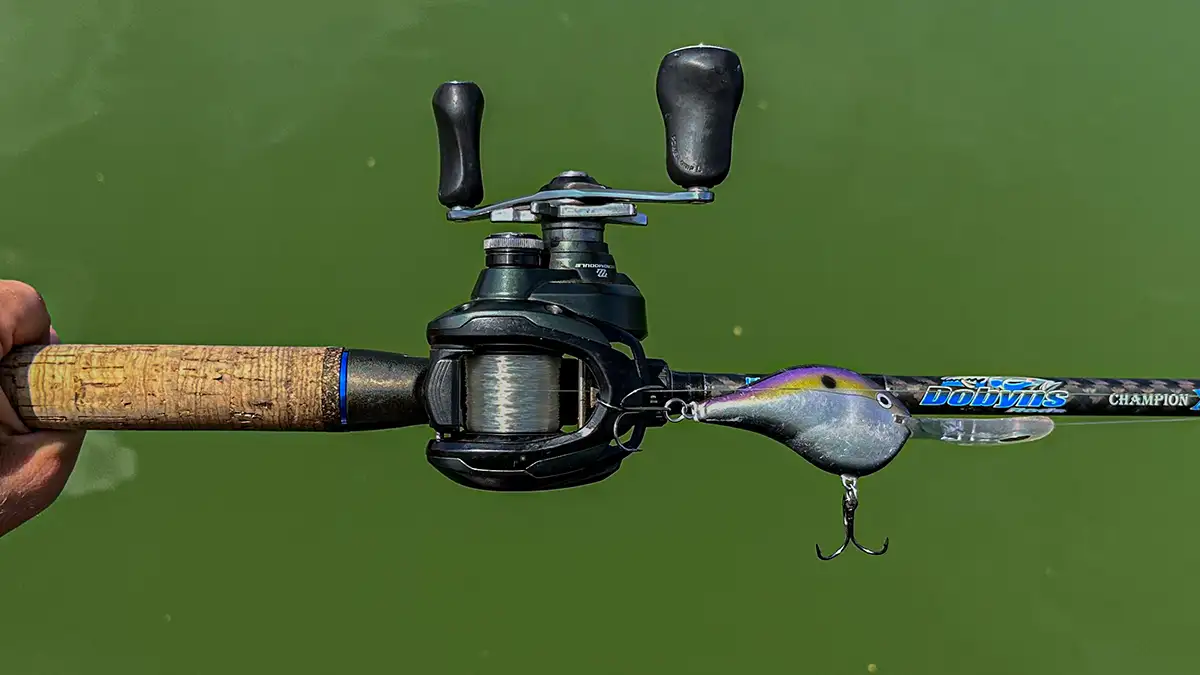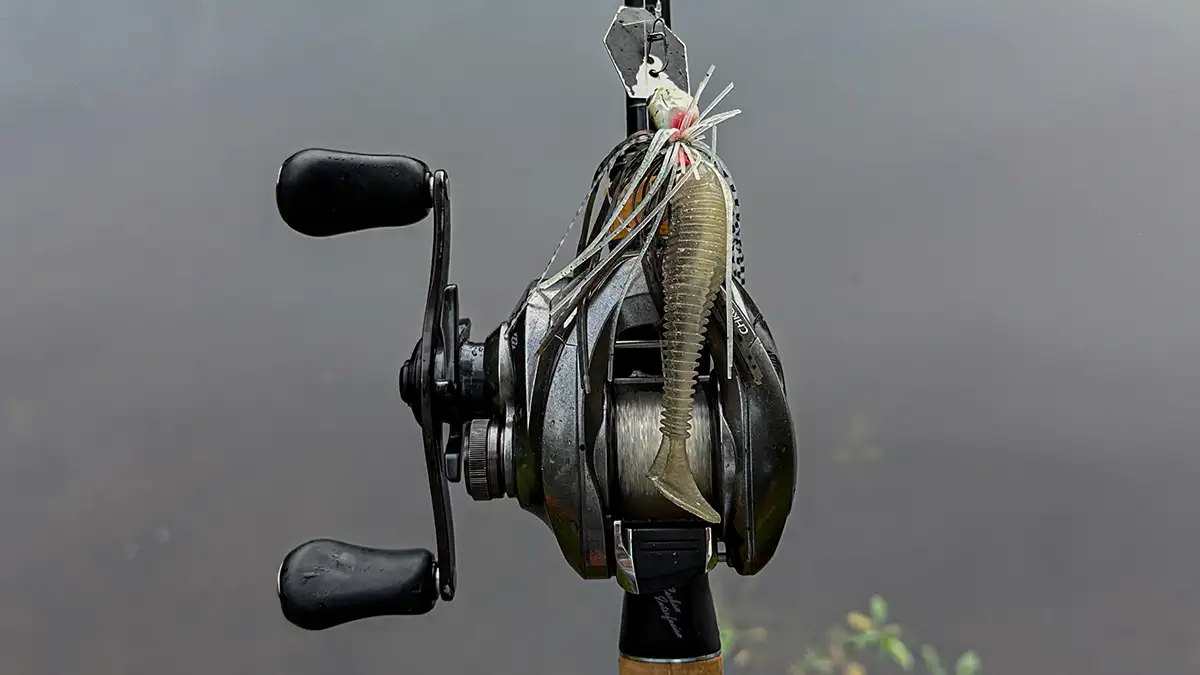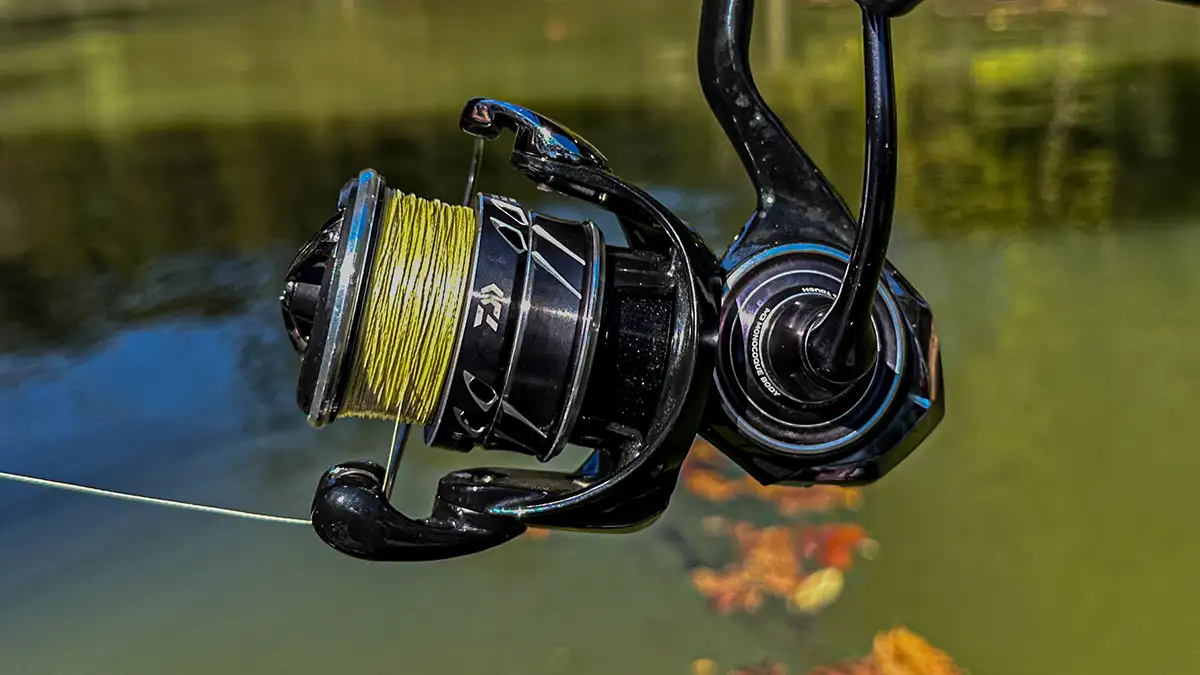Over the years, bass fishing line has slowly progressed from the old school monofilament to numerous new age options. There are multiple kinds of fishing lines with tons of manufactures that all make their own versions. While it is always great to have options, this can make choosing the right fishing line difficult. We’ll explain when to use each type of fishing line based on the line strength, visibility and stretch.
There are three basic types of fishing line as it relates to bass fishing. They include monofilament, fluorocarbon and braided fishing line. Each have qualities and properties that make them useful for different situations. Additionally, each also has potential drawbacks that can impact their effectiveness in certain situations.
Fishing line has progressed exponentially over the last few decades. Some of the oldest lines in fishing are actually braid, however it wasn’t made with the modern materials we are used to seeing nowadays. Instead it was woven with other materials such as silk glands, creating a stiff and slightly transparent line.
Fast forward many years later and monofilament was created. This quickly became the norm thanks to its revolutionary durability and transparency. This line went on to be a bass fishing staple for decades. Since then, both fluorocarbon and modern versions of braided fishing line have taken over the bass fishing market. While fluorocarbon is likely the most commonly used line, all three still have their own time and place based on your chosen technique.
Beyond that understanding line diameter, pound test, stretch and abrasion resistance will help you understand which line to choose and why.
Line Recommendations by BassTechnique
| TECHNIQUE | POUND TEST | LINE TYPE |
| Pitching to sparse cover | 15- to 20-pound | Fluorocarbon |
| Pitching to heavy cover | 20-pound or 65-pound | Fluorocarbon or braid |
| Frogs over matted grass | 65-pound | Braid |
| Cold water jerk baits | 8 to 12-pound | Fluorocarbon or Monofilament |
| Deep diving crankbait | 8 to 15-pound | Fluorocarbon or Monofilament |
| Shallow crankbaits | 10 to 17-pound | Monofilament |
| Lipless crankbaits | 12 to 20-pound | Fluorocarbon or Monofilament |
| Topwaters | 15-pound or 30-pound | Monofilament or Braid |
| Spinnerbaits | 15 to 20-pound | Monofilament |
| Big Swimbaits | 15 to 25-pound or 65-pound | Monofilament or Braid |
| Small Swimbaits | 10 to 15-pound | Fluorocarbon |
| Umbrella Rigs | 65 to 80-pound | Braid |
| Senkos | 8 to 20-pound | Fluorocarbon |
| Big Flutter Spoons | 15 to 25-pound | Fluorocarbon |
| Football jigs | 15 to 20-pound | Fluorocarbon |
| Big Plastic Worms | 12 to 20-pound | Fluorocarbon |
| Jigging Spoons | 10 to 15-pound | Fluorocarbon |
| Drop Shot | 4-10 pound or 10-20 pound | Fluoro leader Braid Backing |
| Shaky Head | 8 to 10-pound | Fluorocarbon |
| Casting Jig | 8 to 12-pound | Fluorocarbon |
| Spy Bait | 6 to 8-pound | Fluorocarbon |
| Skipping jigs | 15 to 20-pound | Fluorocarbon |
| Swimming Jig | 30 to 65-pound | Braid |
HOW TO CHOOSE THE RIGHT FISHING LINE
Fluorocarbon, braid and monofilament all have their own positive and negative attributes that make them great for certain styles of bass fishing. The factors that affect these lines performance are stretch, transparency and durability. It is important to choose a line that fits the correct criteria for your chosen technique. This means that if you are fishing an area with muddy water and heavy cover, you need a line with little stretch and lots of strength. This dirtier water clarity allows you to sacrifice your lines visibility and increase your lines overall durability, allowing for a much thicker gauged line.
However, in a clear water scenario you’d want a more transparent line with a thinner diameter. The increased water clarity calls for a thinner line in order to give your bait more action and a lifelike presentation. Cover and water clarity are often your two biggest factors when deciding what kind of line to throw. Heavy cover means you need something durable, while clear water calls for a transparent, thinner style line. Fluorocarbon, monofilament and braided line are able to tackle any fishing scenario you might encounter thanks to their own unique characteristics.
THREE TYPES OF FISHING LINE

Monofilament
Monofilament is the original transparent fishing line, and is still used for a variety of fishing techniques. Monofilament is clear much like fluorocarbon, however it has a slightly thicker diameter. Monofilament is a single fiber of nylon that is spun individually or with other polymers (co-polymer line) then extruded to form a nylon line that is then wound onto a spool for use on fishing reels. It’s also much stretchier than other types of line fishing line. This can be great for treble hook baits or other techniques with light wire hooks. Monofilament also floats giving baits a unique presentation. This line is much cheaper than both braided and fluorocarbon line, making it the most economical option.
A few of my favorite times to use monofilament is for a leader and deep cranking. I typically tie a monofilament leader when throwing a topwater lure or a Carolina rig. A monofilament leader keeps your line from sinking into the water, making it much easier to work a topwater lure properly. It also keeps your hooks from getting fowled in the braid. Monofilament is also great for a Carolina rig because it allows your bait to float up off the bottom. This gives your bait a weightless presentation which I feel gets more bites compared to a fluorocarbon leader.
Deep cranking is another application where monofilament shines. The added stretch keeps you from ripping the treble hook out of the fishes mouth when winching them to the boat. The thicker gauge line helps to keep you from casting your bait off when throwing magnum sized crank baits, which is a common issue when using fluorocarbon line. This line’s increased abrasion resistance is also great for cranking around timber or other types of cover that can fray your line. Monofilament lines can be extruded to different tensile strengths, also known as pound tests, which essentially determine at what amount of pressure the line will break.I typically use anywhere from 10 to 12-pound monofilament when throwing deep diving crank baits.
They can mix in various polymers to give the line color and refractive properties like fluorescent for being seen under a black light for night fishing.
The 3 critical aspects of monofilament fishing line include pound test, diameter and stretch. The pound test coincides with diameter.
- The heavier the pound test the larger the diameter of the line. The smaller pound test, the smaller the diameter of the line. So 8-pound test line will have a smaller diameter than 20-pound test monofilament. What this means to the angler is 8-pound line will be smaller and more manageable on a fishing reel than 20-pound line. It also means 8-pound mono will stretch more than 20 pound mono. So when you’re fighting a heavier fish, you will have more control over that fish with 20-pound line than you will with 8-pound line. With lighter mono, you’ll have to play the fish down more before trying to land it. With 20-pound mono you can put more pressure on the fish without fear of the line breaking.
- The diameter of fishing line affects how quickly a lure will sink or how deep it will run and also how well it will cast. Generally speaking, a lighter line is a lot easier to cast a lure farther. A lighter line will also sink faster and cut through the water faster so a lure like a crankbait will run much deeper on 8-pound line than it will on 20-pound line.
- You can set the hook harder on 20-pound line because the shock can be handled by the higher tensile strength. While setting the hook on 8-pound line, the line will stretch some on a direct pull but on a hard shocking hookset it will break easily under 8-pounds or more of force. This is when drag on a reel becomes critical. Most anglers will stick with 4 to 10-pound mono on spinning reels and 10 to 25-pound mono on baitcasting reels.

Fluorocarbon
Since the invention of fluorocarbon in 1971, it has remained an extremely popular style of fishing line. In today’s time it is arguably the most popular style of line used for the vast majority of bass fishing techniques under the surface. This is due to the lines overall performance in both clear and dirty water scenarios. Fluorocarbon is extremely transparent while still remaining durable in heavy cover situations. This is a plastic polymer line and is designed to be used in both heavy cover and finesse situations.
This line can be used in numerous techniques, however my favorites are baits with a singular hook such as a jig or spinnerbait. I like fluorocarbon for this style of bait because it gives me enough strength to get a good hook set, while still being clear enough to deliver a lifelike presentation. Fluorocarbon has very little stretch, making it a great option for getting good hook penetration on ticker gauged hooks. I typically using anything from 15 to 20-pound test when throwing a jig or spinnerbait on fluorocarbon line.
Another application fluorocarbon is great for is using it as a leader. When throwing lures such as a Shakey head or drop shot, I will always add a long fluorocarbon leader to the end of my line. This gives your bait a finesse presentation by decreasing the diameter and transparency of your line. A braid to fluorocarbon leader is my go to method for the majority of spinning rod techniques. Anything from an 8 to 12-pound leader is typically standard for this style of fishing.
Fluorocarbon, Polyvinylidene fluoride, is similar to mono but the main property that separates the two would be in light reflection and refraction. Fluorocarbon is less optically dense so it is much harder to see in water as a result. It also has better abrasion resistance than monofilament as it doesn’t absorb water like monofilament will over time. Additionally, fluorocarbon is a little more rigid so it doesn’t stretch like monofilament does.
So you end up with a line that is harder for the fish to see than mono, has better abrasion resistance for fighting fish out of heavy cover and it is more sensitive because it is less forgiving than monofilament. This gives anglers somewhat of an advantage on tempting bass to bite artificial lures.
However it does have a few drawbacks. For starters, because fluorocarbon is a bit more rigid than monofilament, it is a bit less manageable. It will coil more and not stay as limp as monofilament on retrieves. It becomes more noticeable on the larger diameter and pound test lines.
It is also worth noting that fluorocarbon lines sink whereas mono is more neutrally buoyant. This sinking property makes fluorocarbon less desirable for floating lures like topwaters because the sinking line will continually pull the lure’s nose down under the water.
But many anglers have migrated from monofilament to fluorocarbon because of the invisibility, sensitivity and abrasion resistance, albeit at an added expense.
Backing
Because fluorocarbon is more expensive than monofilament, anglers are always seeking to make their fluorocarbon last longer or use less for each reel. Many anglers, myself included, will use “backing” or simply cheaper line to fill up a spool except for the last 60-100 yards which will be the fluorocarbon. This practice allows you to use less fluorocarbon line, respool more often and make a filler spool of line last longer for the same amount of money.
Generally speaking, if you fill up a reel with line. You’re only going to use the last 60 yards or so of it. So it makes sense to use backing. Check out these thoughts on a variation of backing line from Aaron Martens.

Braided Fishing Line
Last but certainly not least, braid is an extremely popular style of fishing line that puts giant bass in the boat all across the country. Braid is the strongest of the three lines, capable of handling any sized fish you throw at it. Braid is essentially, as its name implies, woven strands of material that form a small diameter, no stretch, extremely strong line. The original and most common braids floated. They were often made of materials like cotton or linen. Now braided lines are made of more scientifically crafted materials like Dacron, Spectra and Dyneema.
These more carefully engineered fibers yield strands of woven fibers that do not stretch, have incredible tensile strength and abrasion resistance and very small diameters relative to their pound test. It makes them a great line for fishing for bass around heavy cover where you really have to be able to fight a bass out of or through a lot of dense vegetation or wood. You can also use much higher test line when throwing braid, which allows you to pull fish out of thick mats or other types of cover. Most anglers like a heavier braid like 65-80 pound sizes for fishing heavy cover with hollow bodied or soft plastic frogs or punching through matted vegetation with big weights and soft plastic craws, creatures and beavers.
A few of the most popular techniques for braid are on spinning reels and when fishing heavy cover. I use 10 to 20-pound braid on all my spinning reels for a multitude of reasons. This line allows you to cast long distances with minimal tangles. This line is also much more sensitive which is important for finesse techniques. The lines thin diameter also allows for more line on the spool and increased casting distance. We recommend 10 to 20-pound sizes for spinning gear, drop shot and shaky head presentations. We like a 30-40 pound braid for swim jigs, topwaters and even swimbaits.
However using braid is not all roses either. While this line is stronger and more sensitive, it’s not transparent making it much easier to see. This is why anglers often tie fluorocarbon leaders to their braided line. Additionally, braid can dig into itself more when you wrench down on a hookset or horsing a fish in heavy cover. And it can be more susceptible to wind knots, or tangles that catch your guides, in smaller diameters.
But braided fishing lines have become staples for fishing around grass, fishing topwater lures, and fishing finesse gear on spinning tackle with fluorocarbon leaders. Braid resists line twists much better on spinning gear than either fluorocarbon or monofilament. Braid can be wound tighter on a spool to reduce “digging” and braid definitely gives a lure more casting distance in comparable line diameters.
IN CONCLUSION
Fluorocarbon, monofilament and braid all have their own unique characteristics that make them perform in their own way. While picking the right line may seem confusing at first, it becomes simple when you focus on water clarity and the amount of cover present. While fluorocarbon may be the most popular, all three of these lines have a place in my boat thanks to their differing amounts of strength, transparency and stretch.
And if you want to know how to tie great knots with any of these fishing lines, check out the 15 Knots Every Bass Angler should Know.











